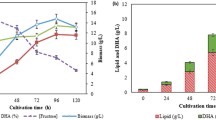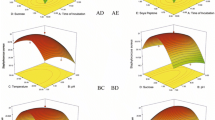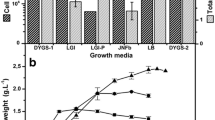Abstract
Optimization of four process parameters was attempted using Box-Behnken design for production of diosgenin by a mixed culture with Aspergillus oryzae, Phanerochaete chrysosporium, and Aspergillus niger. Maximum diosgenin yield of 42.89 ± 0.53 mg/g was obtained after optimization of culture conditions such as Dioscorea zingiberensis C.H.Wright (DZW) concentration 42.98 g/l, inoculum size 1.73 ml of spore suspension (1: 2: 3 ratio of A. oryzae, P. chrysosporium, and A. niger), initial pH 5.0, and cultivation time 5.27 days (127 h) and incubated at 30 °C on a rotary shaker set at 180 r/min as mixed culture.
Access provided by Autonomous University of Puebla. Download conference paper PDF
Similar content being viewed by others
Keywords
- Response surface optimization
- Diosgenin
- Mixed culture
- Aspergillus oryzae
- Phanerochaete chrysosporium
- Aspergillus niger
1 Introduction
Diosgenin (CAS number 512-04-9) is an important steroidal precursor in pharmaceutical industry [1, 2] and used for the synthesis of adrenal cortex hormone, sex hormone, progestational hormone, and anabolic steroid [3, 4]. The tubers of some species of Dioscorea are important sources of diosgenin, early investigation showed that Dioscorea zingiberensis C.H.Wright (DZW) was one of the species containing high concentration of diosgenin [5]. DZW tubers contain 1–2 % diosgenin, 30–40 % starch, 10–15 % lignin, and 40–50 % cellulose [6, 7]. Saponin is diosgenin and attachment of glucose or rhamnose to aglycone by C–O glucosidic bonds, which in plant cells are wrapped by the starch, cellulose, hemicellulose, and lignin [8]. So extraction of diosgenin needs separation of starch and others from Saponin and destroying C–O glucosidic bonds.
The conventional extraction of diosgenin from DZW tubers predominantly uses hydrochloric or sulfuric acid directly for acidic hydrolysis to decompose saponins and starch and so on [9]. As reported by the previous studies [10], the conventional acid approach could produce about 1.20 % diosgenin with high concentration of COD (about 120 g/L) in wastewater and acidic hydrolysis could generate a byproduct 25-spirosta-3, 5-dienes [11]. In addition, many cellulose and starch of DZW were conversed into sugar and discarded together with wastewater, resulting in wasting of resources. Several clean and new technological processes were reported to solve the problem about wastewater and lower yield. For instance, Qiu et al. [12] used ultrasound-assisted extraction for diosgenin. Although this technology for diosgenin production yield could achieve 2.30 %, the process was complex that included ultrasound extraction of the crude material fermented by yeast and then acidic hydrolysis, which is hardly applied in diosgenin industry.
Biotransformation approach is a well-known environmentally friendly technology due to their high selectivity and mild reaction conditions [13]. Zhang [14] applied polyethylene glycol (PEG) to modify cellulase, α-amylase and β-glycosidase were used to hydrolyze the DZW and Liu [15] screening kinds of enzymes draw a conclusion that the cellulase showed the highest efficiency of diosgenin yield. It is reported that the glucosyl residue at C-3 sugar chain of steroidal saponins hardly be hydrolyzed by some enzymes preparations such as β-glucosidase, amylase, and cellulase [16–18]. So acid hydrolysis was still used after enzyme hydrolysis to further improve diosgenin yield. In other hand, the cost of enzyme is expensive.
Microbial hydrolysis was an economic alternative [19, 20], nevertheless, the lower diosgenin yield limited its industrial development. So far, there were few references regarding an approach of microorganism, where mixed culture was used for hydrolyzing starch, lignin, and cellulose of the DZW and used for transforming saponin to diosgenin. Complex mixed cultures are widely used in biotechnology for many processes, e.g., for the production of antibiotics, enzymes, fermented food, composting, dairy fermentation, bioconversion of apple distillery, and domestic wastewater sludge [21]. Application of mixed fermentation to natural product drug discovery seems an obvious extension, but lack of reproducibility [22].
In this work, three fungi Aspergillus oryzae, Phanerochaete chrysosporium, and Aspergillus niger were used by mixed culture to degrade starch, lignin, and cellulose of DZW, biotransformation of saponins to diosgenin, and optimization of process parameters for the production of diosgenin by a mixed culture with these three fungi was carried out using a response surface Box-Behnken design.
2 Materials and Methods
2.1 Microorganism
P. chrysosporium (TCCC41024) was preserved in Tianjin University of Science and Technology Microbiological Culture Collection Center. A. niger (CICC2475) and A. oryzae (CICC40353) were purchased from China Center of Industrial Culture Collection (Beijing, China). These strains were stored at 4 °C on potato dextrose agar slant and subcultured routinely every 2 weeks. To prepare the inocula, spores in a 7-day-old agar slant were, respectively, suspended in 0.01 % Tween 80 solution (107 spores/ml), then mixed spore suspension with 1:2:3 ratios of A. oryzae, P. chrysosporium, and A. niger.
2.2 Materials and Fermentation Condition
The dried DZW tubers were supplied by Kangsheng Company, Qingyang, Gansu, China. The materials were ground by a pulverator (DJ-048 Pulverator, Beijing Huanya Tianyuan Co. Ltd., Beijing, China) and the powder was screened through a 40-mesh stainless steel sieve (0.2 cm). All culture and biotransformation experiments were performed in 250 ml Erlenmeyer flasks. Fermentation medium consisted of the powder DZW and tap water, sterilized by autoclaving for 20 min at 121 °C, inoculated mixed spore suspension, and incubated at 30 °C on a rotary shaker set at 180 r/min for diosgenin production.
2.3 Optimization of Culture Conditions for DZW Concentration, Inoculum Size, Initial pH, and Culture Time
Effect of DZW concentration, inoculum size, initial pH, and culture time were studied, primarily, one variable at a time (date not shown). Based on these experiments, these four independent variables were chosen for the further optimization studies for maximum yield of diosgenin using a response surface methodology (RSM). Variables were coded as −1, 0, and +1 as presented in Table 12.1, which corresponded to the lower, middle, and higher values, respectively. The software Design-Expert (Version 8.0.4, Stat-Ease Inc., Minneapolis, USA) was used for experimental design, the treatment schedule for the model is given in Table 12.2. The response value (Y) in each trial was the average of duplicates.
The general equation of the second degree polynomial is as follows (12.1):
where Y is the predicted response for diosgenin yield; β 0 , β i , β ii , and β ij are constant regression coefficient; and x i and x j (i = 1, 3; j = 1, 3, i ≠ j) represent the independent variables in the form of coded values.
2.4 Extraction and Analysis Diosgenin
At the end of culture, the steroidal saponins extraction was according to zhu et al. [20], the fermentation sample was centrifuged, dried at 60 °C, extracted with chloroform, and ultrasonicated for 30 min (KQ3200B ultrasonicator); centrifuged and analyzed on Agilent 1100 Multi-solvent Delivery System equipped with a Phenomsil C18 column, 250 × 4.6 mm (5 μm), the injection volume for all samples was 20 μl. The mobile phase column temperature of 30 °C.
3 Results and Discussion
Interactive effects of the factors, concentration of DZW, inoculation size, pH, and culture time, were examined by RSM using Box-Behnken design. The actual yield of diosgenin yield (response) obtained is presented in Table 12.2. The ANOVA analysis yielded the following regression Eq. (12.2) in terms of the levels of diosgenin yield (Y) as a function of concentration of DZW (A), inoculation size (B), pH (C), and culture time (D).
The subsequent analysis of variance showed aptness of the model for diosgenin production. The computed F-value of 52.00 implies significance of the model. There is only a 0.01 % chance that a model F-value this large could occur due to noise. The lack-of-fit F-value is not significant, and there is only a 6.28 % chance that a lack-of-fit F-value this large could occur due to noise. The model was found to be highly significant and occur due to noise. The lack-of-fit F-value is not sufficient to represent the actual relationship between the response and the significant variables as indicated by the small model P value (<0.0001), large lack-of-fit P-value (0.0628), suitable coefficient of determination (R 2 = 0.9811), and adjusted coefficient of determination (R 2adjusted = 0.9623) from ANOVA (Table 12.3). The predicted sum of squares (PRESS) of 314.23 indicated fit of each point in this design. Signifiance of seven model terms (A, B, C, D, A 2, B 2, C 2, and D 2) and an adequate precision of 20.624 indicated low signal-to-noise ratio (Table 12.4).
Response surface contour plots graphically represented regression equations and were generally used to demonstrate relationships between the response and experimental levels of each variable in case of diosgenin yield (Fig. 12.1a–d). The points on the corners and center of the figure represent experimental design points. The point with number five in the center contour plots indicates the highest predicted value of selected variable with other variables constant at centra level.
a Response surface contour plots showing effect of concentration of DZW and inoculation size on diosgenin yield in mixed culture with other variables constant at centra level. b Response surface contour plots showing effect of concentration of DZW and pH on diosgenin yield in mixed culture with other variables constant at centra level. c Response surface contour plots showing effect of inoculum size and culture time on diosgenin yield in mixed culture with other variables constant at centra level. d Response surface contour plots showing effect of inoculum size and pH on diosgenin yield in mixed culture with other variables constant at centra level
Our results showed that the DZW concentration in the medium was the most significant single parameter which influenced diosgenin yield followed by culture time, inoculum size, and initial pH (Table 12.2). The interactions between DZW concentration and inoculum size, DZW concentration and pH, inoculum size and culture time, and that between pH and inoculum size also had significant effects.
The results presented in Fig. 12.1 indicated that the DZW concentration influenced diosgenin yield independent of the inoculum size. A 50 g/l concentration of DZW was selected as appropriate level since any further increase in concentration resulted in an undesirable increase of viscosity of the medium, causing negative effect of the growth of fungi and decreasing diosgenin yield per gram of the DZW. Higher concentration of DZW always necessitated the requirement of a higher inoculum size, while at lower levels of DZW concentration, the yield increased initially with increase in inoculum size and then decreased. When there is lesser DZW in the medium, the addition of more inoculum probably result in a competition, with the result that growth and productivities might be affected which could be the reason for this observation [23]. The effect of pH and concentration of DZW on diosgenin yield, and the effect of pH and inoculum size on diosgenin yield were presented in Fig. 12.1b and d. Diosgenin yields increased with increasing pH up to a value of 5.0 pH influenced enzyme activity which play leading role for hydrolysis saponin. The appropriate pH of cellulase [24], glucoamylase [17], and β-glycosidase [25] is about 5. The yields of diosgenin were determined to be maximum at culture time of 5 days, no increase beyond culture time (Fig. 12.1c).
Analysis of response-surface curves and contour plots indicated optimum levels of the variables necessary to achieve better results. The results predicted by Box-Behnken design showed that a combination of concentration of DZW 42.98 g/l, inoculation size 1.73 ml, pH 5.0, and cultivation time 5.27 days (127 h), the diosgenin yield was 42.77 mg/g. A repeat fermentation of DZW for highest production of diosgenin by mixed culture under optimal conditions was carried out for verification of the optimization. Maximum diosgenin production was 42.89 ± 0.53 mg/g closely agree with the predicted value. The final diosgenin yield of optimization process increased by 61.18 % compared to the acid hydrolysis of DZW (26.61 ± 0.78 mg/g).
4 Conclusion
We report a study involving A. oryzae, P. chrysosporium, and A. niger for the production of diosgenin from DZW by mixed culture. Response-surface methodology was adopted to optimize the variables and to study their influence on diosgenin yield. The results predicted by Box-Behnken design showed that a combination of concentration of DZW 42.98 g/l, inoculation size 1.73 ml, pH 5.0, and cultivation time 5.27 days (127 h), which would yield a maximum yield of 42.77 mg/g diosgenin. Evaluation experiments carried out to verify the predictions revealed that three fungi yield 42.89 ± 0.53 mg/g closely agree with the predicted value.
References
Fernandes P, Cruz A, Angelova B et al (2003) Microbial conversion of steroids compounds: recent developments. Enzym Microb Technol 32:688–705
Saunders R, Cheetham PSJ, Hardman R (1986) Microbial transformation of crude fenugreek steroids. Enzym Microb Technol 8:549–555
Huang W, Zhao HZ, Ni JR et al (2008) The best utilization of D. zingiberensis C.H. Wright by an eco-friendly process. Bioresour Technol 99:7407–7411
Zhang CX, Wang YX, Yang ZH (2006) Chlorine emission and dechlorination in co-firing coal and the residue from hydrochloric acid hydrolysis of Discorea zingiberensis. Fuel 85:2034–2040
Ding Z, Zhou L, Wang Y et al (1981) Factors influencing diosgenin content of Dioscorea zingiberensis. Chin Tradit Herb Drugs 12:34–35
Li MX, Hu SB, Wang YJ et al (2010) Optimizated conditions of acid-microorganism-enzyme co-degradation to process residue of Dioscorea zingiberensis saponin production. Acta Agric Boreali-Occidentalis Sinica 19:196–201
Zhu YL, Ni JR, Huang W (2010) Process optimization for the production of diosgenin with Trichoderma reesei. Bioprocess Biosyst Eng 33:647–655
Adham NZ, Zaki RA, Naim N (2009) Microbial transformation of diosgenin and its precursor furostanol glycosides. World J Microbiol Biotechnol 25:481–487
Cheng P, Zhao HZ, Zhao B (2009) Pilot treatment of wastewater from Dioscorea zingiberensis C.H. Wright production by anaerobic digestion combined with a biological aerated filter. Bioresour Technol 100:2918–2925
He XJ, Liu B, Wang GH (2006) Microbial metabolism of methyl protodioscin by Aspergillus niger culture—a new androstenedione producing way from steroid. J Steroid Biochem Mole Biol 100:87–94
Peng Y, Yang ZH, Wang YX et al (2011) Pathways for the steroidal saponins conversion to diosgenin during acid hydrolysis of Dioscorea zingiberensis C.H.Wright. Chem Eng Res Des 89:2620–2625
Qi LL, Hai NB, Huang W (2011) Ultrasonic and fermented pretreatment technology for diosgenin production from Diosorea zingiberensis C.H.Wright. Chem Eng Res Des 89:239–247
Wendy AL (2000) Biotransformations in organic synthesis. Bioresour Technol 74:49–62
Yq Zhang, Tang L, An X et al (2009) Modification of cellulase and its application to extraction of diosgenin from Dioscorea zingiberensis C.H. Wright. Biochem Eng J 47:80–86
Liu W, Huang W, Sun WL et al (2006) Production of diosgenin from yellow ginger (Dioscorea zingiberensis C.H.Wright) saponins by commercial cellulase. World J Micro Biotechnol 26:1171–1180
Ma BP, Feng B, Huang HZ et al (2010) Biotransformation of Chinese herbs and their ingredients. TCM Materia Medica 12:150–154
Feng B, Hu W, Ma BP et al (2007) Purification, characterization, and substrate specificity of a glucoamylase with steroidal saponin-rhamnosidase activity from Curvularia lunata. Appl Microbiol Biotechnol 76:1329–1338
Feng B, Huang HZ, Zhou WB et al (2010) Substrate specificity, purification and identification of a novel pectinase with the specificity of hydrolyzing the α-1,4-glycosyl residue in steroidal saponin. Process Biochem 45:1383–1392
Dong YS, Teng H, Qi SS (2010) Pathways and kinetics analysis of biotransformation of Dioscorea zingiberensis by Aspergillus oryzae. Biochem Eng J 52:123–130
Liu L, Dong YS, Qi SS et al (2010) Biotransformation of steriodal saponins in Dioscorea zingiberensis C. H. Wright to diosgenin by Trichoderma harzianum. Appl Microbiol Biotechnol 85:933–940
Alam MZ, Fakhru’l-Razi SA, Abd-Aziz A (2001) Bioconversion of wastewater sludge by immobilized microbial treatment. In: Proceedings of the international water association (IWA) conference on water and waste water management for developing countries, Kauala Lampur, Malaysia, PP 344–353
Robin K, Pettit (2009) Mixed fermentation for natural product drug discovery. Appl Microbiol Biotechnol 83:19–25
Rojan P, Rajeev K, Sukumaran K et al (2007) Statistical optimization of simultaneous saccharification and l(+)-lactic acid fermentation from cassava bagasse using mixed culture of lactobacilli by response surface methodology. Biochem Eng J 36:262–267
Percival Zhang YH, Michael EH, Jonathan RM (2006) Outlook for cellulase improvement: screening and selection strategies. Biotechnol Adv 24:452–481
Lei J, Niu H, Li TH et al (2012) A novel β-glucosidase from Aspergillus fumigates releases diosgenin from spirostanosides of Dioscorea zingiberensis C.H. Wright (DZW). World J Microbiol Biotechnol 28:1309–1314
Acknowledgments
This work was financially supported by the Tianjin Science and Technology Support Plan Project (10ZCKFSH0060) and the Natural Science Foundation of China (No. 20906071).
Author information
Authors and Affiliations
Corresponding author
Editor information
Editors and Affiliations
Rights and permissions
Copyright information
© 2014 Springer-Verlag Berlin Heidelberg
About this paper
Cite this paper
Xie, J., Xu, X., Bie, S. (2014). Optimization of Diosgenin Production by Mixed Culture Using Response Surface Methodology. In: Zhang, TC., Ouyang, P., Kaplan, S., Skarnes, B. (eds) Proceedings of the 2012 International Conference on Applied Biotechnology (ICAB 2012). Lecture Notes in Electrical Engineering, vol 249. Springer, Berlin, Heidelberg. https://doi.org/10.1007/978-3-642-37916-1_12
Download citation
DOI: https://doi.org/10.1007/978-3-642-37916-1_12
Published:
Publisher Name: Springer, Berlin, Heidelberg
Print ISBN: 978-3-642-37915-4
Online ISBN: 978-3-642-37916-1
eBook Packages: EngineeringEngineering (R0)





